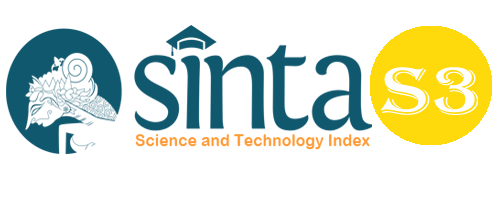Social Media Application Support Management of Human Resource in Business
Abstract
Teenagers and students favor this social media application to make friends and share their life stories. With its various exciting applications, this social media application has attracted professionals in running a business, significantly to improve the quality of life of their human resources. We have proven the truth and error of this assumption by examining literature sources from various domestic and international publications that discuss the advantages and disadvantages of social media in supporting the improvement of human resources among the public. Our data is analyzed using a phenomenological approach, exploring as much data as possible. We analyze it by involving an interpretation coding system in concluding according to the purpose of this study which aims to get the broadest understanding of how social media applications can help improve the quality of human resources. Based on data and scientific evidence, we can report that social media is increasingly being used not only for friendship but also to increase the quality of the company's human resources. Hopefully, this finding will be essential in improving human resources through social media applications.
Keywords
Full Text:
PDFReferences
Alase, A. (2017). The interpretative phenomenological analysis (IPA): A guide to an excellent qualitative research approach. International Journal of Education and Literacy Studies, 5(2), 9-19.
Ausubel, D. P. (2012). The acquisition and retention of knowledge: A cognitive view Springer Science & Business Media.
Baumeister, R. F., Masicampo, E., & Vohs, K. D. (2011). Do conscious thoughts cause behavior? Annual Review of Psychology, 62, 331-361.
Bizzi, L. (2020). Should HR managers allow employees to use social media at work? Behavioral and motivational outcomes of employee blogging. The International Journal of Human Resource Management, 31(10), 1285-1312.
Boehm, J., Kayser, M., & Spiller, A. (2010). Two sides of the same coin? Analysis of the web-based social media about the image of the agri-food sector in Germany. International Journal on Food System Dynamics, 3, 264-278.
Bolton, R. N., Parasuraman, A., Hoefnagels, A., Migchels, N., Kabadayi, S., Gruber, T., . . Solnet, D. (2013). Understanding generation Y and their use of social media: A review and research agenda. Journal of Service Management.
Bondarouk, T., Ruël, H., Axinia, E., & Arama, R. (2014). What is the future of employer branding through social media? Results of the Delphi study into the perceptions of HR professionals and academics. Social media in human resources management () Emerald Group Publishing Limited.
Brogan, C. (2010). Social media 101: Tactics and tips for online business: John Wiley & Sons.
Chaka, C. (2020). Scoping review, skills, competencies, and literacies attributed to 4IR/Industry 4.0. IFLA Journal, 46(4), 369-399.
Chelladurai, P., & Kerwin, S. (2018). Human resource management in sport and recreation Human Kinetics.
Cramer, R. D. (2019). When big data was small: My life in baseball analytics and drug design U of Nebraska Press.
Curran, K., Graham, S., & Temple, C. (2011). Advertising on Facebook. International Journal of E-Business Development, 1(1), 26-33.
Dacholfany, M. I. (2017). Inisiasi strategi manajemen lembaga pendidikan Islam dalam meningkatkan mutu sumber daya manusia islami di Indonesia dalam menghadapi era globalisasi. At-Tajdid: Jurnal Pendidikan Dan Pemikiran Islam, 1(01)
Eagly, A. H., & Carli, L. L. (2018). Women and the labyrinth of leadership Routledge.
Faulkner, R. R., & Fred, S. (2017). Music on Demand: Composers and Careers in the Hollywood film industry Routledge.
Gravili, G., & Fait, M. (2016). Social recruitment in HRM: A theoretical approach and empirical analysis Emerald Group Publishing.
Habermas, J. (2014). The future of human nature John Wiley & Sons.
Harold, S., Beauchamp-Mustafaga, N., & Hornung, J. (2021). Chinese Disinformation Efforts on Social Media.
Harper, D. (2011). Choosing a qualitative research method. Wiley Blackwell.
Hartini, R. (2020). Pengaruh aplikasi human resource information system terhadap kinerja karyawan di pt mandom Indonesia tbk. Paper presented at the Conference on Innovation and Application of Science and Technology (CIASTECH), , 3(1) 39-46.
Hartwell, C. J. (2018). Social media and e-HRM. e-hrm (pp. 123-139) Routledge.
Hogg, J. (2010). Designing an experiential web-based learning model to deliver the acquisition and application of knowledge to hospitality events.
Jamshed, S. (2014). Qualitative research method-interviewing and observation. Journal of Basic and Clinical Pharmacy, 5(4), 87-88. doi:10.4103/0976-0105.141942 [doi]
Kamenetz, A. (2018). The art of screen time: How your family can balance digital media and real-life Hachette UK.
Kaplan, A. M., & Haenlein, M. (2010). Users of the world, unite! The challenges and opportunities of social media. Business Horizons, 53(1), 59-68.
Karacay, G. (2018). Talent development for industry 4.0. Industry 4.0: Managing the digital transformation (pp. 123-136) Springer.
Kluemper, D. H., Mitra, A., & Wang, S. (2016). Social media use in HRM. Research in personnel and human resources management () Emerald Group Publishing Limited.
Kultgen, J. (2010). Ethics and professionalism University of Pennsylvania Press.
Lange, J. S. (2010). Human resource management in Indonesia: Important issues to know before establishing a subsidiary in Indonesia Diplomica Verlag.
Linders, D. (2012). From e-government to we-government: Defining a typology for citizen coproduction in the age of social media. Government Information Quarterly, 29(4), 446-454.
Lobert, A. (2017). Penfriendships, exchange economies, and “FBs”: Take that fans networking before the digital revolution. Fan Identities and Practices in Context: Dedicated to Music, 185.
Mehrotra, A., Hendley, R., & Musolesi, M. (2016). PrefMiner: Mining user's preferences for intelligent mobile notification management. Paper presented at the Proceedings of the 2016 ACM International Joint Conference on Pervasive and Ubiquitous Computing, 1223-1234.
Mikalef, P., Giannakos, M., & Pateli, A. (2013). Shopping and word-of-mouth intentions on social media. Journal of Theoretical and Applied Electronic Commerce Research, 8(1), 17-34.
Moriansyah, L. (2015). Pemasaran melalui media sosial: Antecedents dan consequences social media marketing: Antecedents and consequenc-es. Jurnal Penelitian Komunikasi Dan Opini Publik, 19(3), 187-196.
Mugisha, D. (2021). Rhetorical criticism of fan culture on social media platforms.
Niati, D. R., Siregar, Z. M. E., & Prayoga, Y. (2021). The Effect of Training on Work Performance and Career Development: The Role of Motivation as Intervening Variable. Budapest International Research and Critics Institute (BIRCI-Journal): Humanities and Social Sciences, 4(2), 2385–2393. https://doi.org/10.33258/birci.v4i2.1940
Nivlouei, F. B. (2014). Electronic, human resource management system: The main element incapacitating globalization paradigm. International Journal of Business and Social Science, 5(2).
Noprianto, E. (2018). Pemanfaatan media sosial dan penerapan social media analytics (SMA) untuk perpustakaan di indonesia. Jurnal Pustaka Budaya, 5(2), 1-10.
Pittman, M., & Reich, B. (2016). Social media and loneliness: Why an Instagram picture may be worth more than a thousand twitter words. Computers in Human Behavior, 62, 155-167.
Purcarea, I., Espinosa, Maria del Mar Benavides, & Apetrei, A. (2013). Innovation and knowledge creation: Perspectives on the SMEs sector. Management Decision.
Puspitacandri, A. (2020). The effects of intelligence, emotional, spiritual, and adversity quotient on the graduates quality in Surabaya shipping polytechnic. European Journal of Educational Research, 9(3), 1075-1087.
Resnick, P., Konstan, J., Chen, Y., & Kraut, R. E. (2012). Starting new online communities. Building Successful Online Communities: Evidence-Based Social Design, 231.
Schultz, D. E., & Peltier, J. J. (2013). Social media's slippery slope: Challenges, opportunities, and future research directions. Journal of Research in Interactive Marketing,
Segerberg, A., & Bennett, W. L. (2011). Social media and the organization of collective action: Using Twitter to explore the ecologies of two climate change protests. The Communication Review, 14(3), 197-215.
Shah, M. M., et al. (2020). The Development Impact of PT. Medco E & P Malaka on Economic Aspects in East Aceh Regency. Budapest International Research and Critics Institute-Journal (BIRCI-Journal) Volume 3, No 1, Page: 276-286.
Shu, C., Page, A. L., Gao, S., & Jiang, X. (2012). Managerial ties and firm innovation: Is knowledge creation a missing link? Journal of Product Innovation Management, 29(1), 125-143.
Sima, V., Gheorghe, I. G., Subić, J., & Nancu, D. (2020). Influences of the industry 4.0 revolution on the human capital development and consumer behavior: A systematic review. Sustainability, 12(10), 4035.
Smith, S. A. (2013). If dr. Martin Luther King, jr. had a Twitter account: A look at collective action, social media, and social change. Seattle J.Soc.just., 12, 165.
Sutono, A., & Par, M. (2020). PARIWISATA DAN KETAHANAN NASIONAL: Percepatan pembangunan pendidikan vokasi bidang pariwisata berbasis penta helix guna peningkatan daya saing bangsa dalam rangka ketahanan nasional UPT Penerbitan dan Percetakan-Universitas Pendidikan Indonesia.
Teherani, A., Martimianakis, T., Stenfors-Hayes, T., Wadhwa, A., & Varpio, L. (2015). Choosing a qualitative research approach. Journal of Graduate Medical Education, 7(4), 669-670.
Walker-Roberts, G. S. (2020). Non-Traditional Online Students' Perceptions of how Advisor Interactions Contribute to Degree Completion Rates: A Phenomenological Study.
Webb, T. L., Miles, E., & Sheeran, P. (2012). Dealing with feeling: A meta-analysis of the effectiveness of strategies derived from the process model of emotion regulation. Psychological Bulletin, 138(4), 775.
Wehrmeyer, W. (2017). Greening people: Human resources and environmental management Routledge.
Werdhiastutie, A. et al. (2020). Achievement Motivation as Antecedents of Quality Improvement of Organizational Human Resources. Budapest International Research and Critics Institute-Journal (BIRCI-Journal) Volume 3, No 2, Page: 747-752.
Wolf, M. V., Sims, J., & Yang, H. (2014). Social media utilization in human resource management. Paper presented at the 8th Multi-Conference on Computer Science and Information Systems, 2-6.
Zapata-Cantu, L. (2021). The evolution of knowledge transfer in Mexico, from physical to virtual spaces. International HRM and Development in Emerging Market Multinationals, 173-191.
DOI: https://doi.org/10.33258/birci.v4i4.3534
Article Metrics
Abstract view : 107 timesPDF - 32 times
Refbacks
- There are currently no refbacks.

This work is licensed under a Creative Commons Attribution-ShareAlike 4.0 International License.

This work is licensed under a Creative Commons Attribution-ShareAlike 4.0 International License.

_.gif)

















_.gif)



